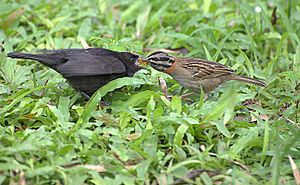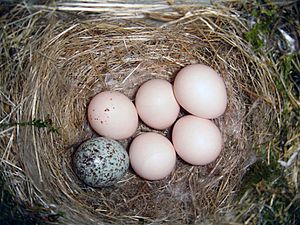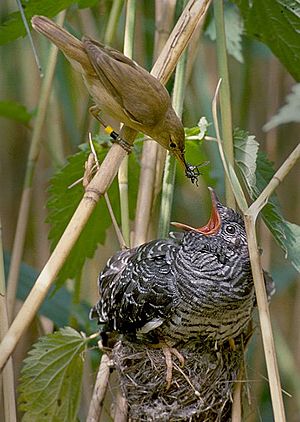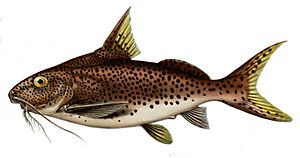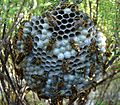Brood parasitism facts for kids
Brood parasites are clever animals, usually birds, that trick other species into raising their babies. Imagine another animal laying its eggs in someone else's nest! The most famous example is the cuckoo bird. These parasites often grow faster than the host's own eggs. They might even push the original eggs or chicks out of the nest. The adult host parents don't seem to notice the difference. They end up spending all their time feeding and caring for the young of another species. Sometimes, the parasite chicks can even make sounds that sound just like the host's own babies!
Some fish and insects also use similar sneaky methods to raise their young.
Contents
Birds: Tricky Egg-Layers
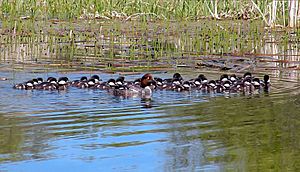
Many bird species usually have one partner for raising young. But sometimes, females lay their eggs in the nests of other birds. This is a way for them to avoid the hard work of raising their own chicks. For example, the common goldeneye duck often lays its eggs in another female's nest. This is called intraspecific brood parasitism because it happens within the same species. Many other duck species do this too.
Some birds are even trickier. They lay their eggs in the nests of completely different species. This is called interspecific brood parasitism. Famous examples include indigobirds, whydahs, and honeyguides from Africa. In the Americas, we have cowbirds and some cuckoos. The black-headed duck also does this. Scientists believe this sneaky behavior started independently in birds at least seven times!
Most birds that do this are specialists. This means they only trick one type of host bird, or a small group of similar host birds. But four out of five types of parasitic cowbirds are generalists. They can trick many different kinds of birds. The brown-headed cowbird, for instance, is known to trick over 221 different host species! Usually, they lay only one egg per nest. But sometimes, several cowbird females might use the same host nest.
The common cuckoo is very interesting. As a whole species, cuckoos trick many different hosts, like the reed warbler and dunnock. But each individual female cuckoo specializes in just one host species. The genes that control the egg's color are passed down only from the mother. This allows female cuckoos to lay eggs that look just like the eggs of their chosen host. Female cuckoos usually lay eggs in the nests of the same species that raised them. Male cuckoos, however, mate with females from all these different lines. This helps keep the cuckoo species strong and prevents them from splitting into new species.
Fish: Sneaky Swimmers
Mouthbrooding Parasites
In Lake Tanganyika, there's a catfish called Synodontis multipunctatus. This fish is a brood parasite of several cichlid fish that carry their eggs in their mouths (this is called mouthbrooding). The catfish eggs hatch inside the host's mouth even before the host's own eggs do. The young catfish then eat the host's baby fish right inside the host's mouth! This way, the catfish babies get all the care and food from the host parent.
Nest Parasites
A small minnow fish, Pungtungia herzi, is a brood parasite of the freshwater perch Siniperca kawamebari. These perch live in Japan and South Korea. The male perch guards a territory during breeding season. He creates a "nest" area in the reeds for spawning. Female perch visit this spot to lay their eggs, which the male then protects. The parasite minnow's eggs are smaller and stickier than the perch's eggs. In one study, over 65% of perch nests were found to have minnow eggs!
Insects: Food Thieves
Kleptoparasites
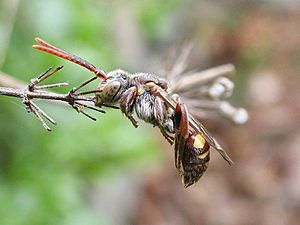
There are many kinds of cuckoo bees. They all lay their eggs in the nests of other bees. But they are usually called kleptoparasites (which means "food thieves"). This is because the young cuckoo bees are almost never fed directly by the adult host bees. Instead, they simply steal and eat the food that the host bees gathered for their own young. Some examples of cuckoo bees are Coelioxys rufitarsis, Melecta separata, Bombus bohemicus, Nomada, and Epeoloides.
Kleptoparasitism isn't just for bees. Several types of wasps also do this, including most of the cuckoo wasps. Cuckoo wasps lay their eggs in the nests of other wasps, like potter wasps and mud daubers.
Images for kids
-
Four clutches of reed warbler eggs, each containing one (larger) cuckoo egg
-
A black-collared starling feeding an Asian koel
-
Nest of Polistes dominula, host to the cuckoo wasp P. sulcifer
See also
 In Spanish: Parasitismo de puesta para niños
In Spanish: Parasitismo de puesta para niños


